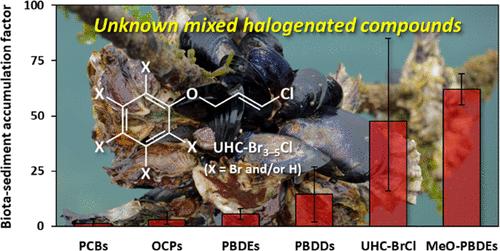Nontarget and target screening of organohalogen compounds in mussels and sediment from Hiroshima Bay, Japan

Credit: Reprinted with permission from Environmental Science & Technology.
© 2020 American Chemical Society
A research team in Ehime University found novel bioaccumulative compounds in mussels inhabiting Hiroshima Bay and suggested their unintentional (natural) formation in the environment. The findings were published on March 12, 2020 in Environmental Science & Technology and selected as a supplementary cover of the journal.
Persistent organic pollutants (POPs) such as polychlorinated biphenyls (PCBs), dichlorodiphenyltrichloroethanes (DDTs), and dioxins possess environmentally persistent and bioaccumulative properties and can cause adverse effects on humans and wildlife. POPs are strictly regulated and targeted for abolition (prohibition of production and usage) and for reduction of unintentional formation according to the Stockholm Convention on POPs. Since the Stockholm Convention came into effect in May 2004, several organohalogen compounds (OHCs) have additionally been registered as new POPs. However, legacy and emerging POPs drawing international attention are confined to well-known anthropogenic OHCs, and hence environmental release and biological exposure of unknown POP-like substances have been overlooked.
Another emerging issue is the natural formation of OHCs in the coastal environment. Several halogenated natural products (HNPs), which are biosynthesized by marine algal and bacterial species, are known to have POP-like physicochemical properties and toxicological effects. Although it is likely that marine biota is chronically exposed to OHCs from both anthropogenic and natural origins, there is a lack of comprehensive screening surveys, especially for low-trophic level organisms such as marine fish and shellfish. Therefore, the origin and bioaccumulation potential for POP-like substances present in the coastal environment remain unclear.
The research team in Ehime University screened known and unknown POP-like substances in mussels and sediment sampled from Hiroshima Bay by using advanced instrumental methods including comprehensive two-dimensional gas chromatography/high-resolution time-of-flight mass spectrometry (GCxGC/HRToFMS) and GC/magnetic sector HRMS. In addition to known OHCs (POPs and HNPs), unknown mixed halogenated compounds containing one chlorine and three to five bromines (UHC-Br3–5Cl) with molecular formulae of C9H6Br3ClO, C9H5Br4ClO, and C9H5Br4ClO were detected. These unknown compounds were found to be ubiquitous in the bay coast despite not being produced commercially, suggesting the unintentional (natural) formation in the coastal environment. The biota (mussel)-sediment accumulation factors (BSAFs) of UHC-Br3–5Cl were an order of magnitude higher than those for POPs with similar log octanol-water partition coefficient (log Kow) values, indicating their high bioaccumulative potential. Thus, comprehensive monitoring and ecotoxicological risk assessment on anthropogenic and natural OHCs targeted for a wide range of trophic-level marine organisms are necessary.
###
Media Contact
Public Relations Division
[email protected]
Original Source
https:/
Related Journal Article
http://dx.




